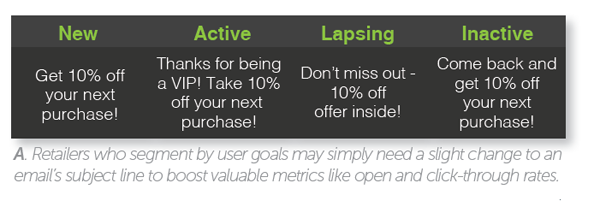Levels of Relevance and Revenue: A Guide to Personalization through Segmentation

By Ryan Hofmann, Chief Brand Strategist
at Listrak
Retailers' top goal for their email marketing campaigns tends to be a three-way tie between delivering highly relevant content, driving additional site traffic and increasing conversions/revenue.
Ironically, much lower on the list of goals is segmenting their database, which is precisely what is called for to achieve the first three. The most commonly cited barriers to achieving relevance are time, talent, creative, content and data. Retail marketers often lack the necessary human resources, skills and/or expertise, and often have challenges in creating relevant content consistently and predictably, as well as easily merging email data with other systems. What many do not realize, however, is that by strategically using automation, personalization and optimization, it's simple to begin knocking down the barriers and start driving both relevance and revenue.
The first step is for retailers to address the shopping experience they'd like to deliver. For example, if an in-store customer tells a sales associate he is looking for a new dress shirt, the associate surely would not respond by telling him about a bathing suit sale. That, however, is precisely what retailers do every day when they blast the same marketing email to every subscriber, ignoring the fact that, through their behavioral and purchase history, subscribers have already expressed what they are interested in.
Promotional targeting and segmentation are the building blocks to relevant, revenue-driving email campaigns. Email marketers should look at segmentation as a journey or an evolution, one that involves laying foundational building blocks that are necessary to progressing to the next level of marketing maturity and sophistication. Using the following five-stage marketing maturity framework, marketers are able to move their program from one level to the next and drive significant revenue while doing so.
Level 1: Batch and Blast
When it comes to segmentation, unfortunately, far too many retail email marketers remain at the rudimentary, one-size-fits-all level, delivering the same content to everyone on the list.
Level 2: Reporting-Based Segmentation
All email marketers have reporting data at their fingertips, and it's a great place to start. It's easy to identify a few specific customer dimensions such as buyers and non-buyers. At first, the segments may continue to get the same content. Over time, however, the retailer will be able to begin seeing differences in how the two segments perform, and from there be able to determine, for example, whether or not to create offers for non-customers.
Level 3: Activity-Based or Goal-Based Segmentation
The next step in segmentation is to divide subscribers based on their activity. New, active, lapsing and inactive customers should each, ideally, be receiving content relevant to their activity level to optimize results. That may sound like a lot of extra work, but it doesn't have to be. Using the four quadrants (as shown in image A), keeps it manageable, and can drive significant results. Keeping the goals in mind for each segment, a simple change in subject may be all that's needed. The next step, of course, would be to tweak the email creative, which can be as simple as adjusting the copy in the primary message content area.

Similarly, retailers can do activity-based segmentation with the same groups without having to extend an offer (see image B).

Not surprisingly, retailers see the most lift from activity-based segmentation with their new and active customers - a 10 to 20 percent lift with this approach when addressing these segments. From the lesser-engaged lapsing and inactive groups, however, there is a lift, but often it is much smaller (between 3-7 percent). To optimize activity-based segmentation, retailers can increase the complexity and look at how they might target non-customers and high-value customers as another dimension of this approach, as well.
Level 4: Behavior-Based Targeting
The most mature segmentation level is behavior-based, and it requires the most comprehensive data. For retailers who have online transactional and browsing, in-store point of sale (POS) and browsing data at the category, brand and product level, there is no end to the creative ways they can segment to boost relevancy and revenue. Further, with an automated personalization solution in place, they can ensure that not only are they reaching highly targeted segments with the most relevant messaging, but also that literally no two subscribers' emails are the same.
Level 5: Predictive Segmentation
While most segmentation and targeting are done with historical data, the next level of segmentation is based on anticipated behavior: when a retailer expects a customer to make a next purchase, what category that purchase will be in, what brand and even which specific product.
As marketers move from one level of marketing segmentation to the next, they'll find that they are indeed achieving their primary objectives of delivering relevant content, driving traffic and, most importantly, increasing revenue.

Subscribe to Our Newsletter!
Latest in Marketing








